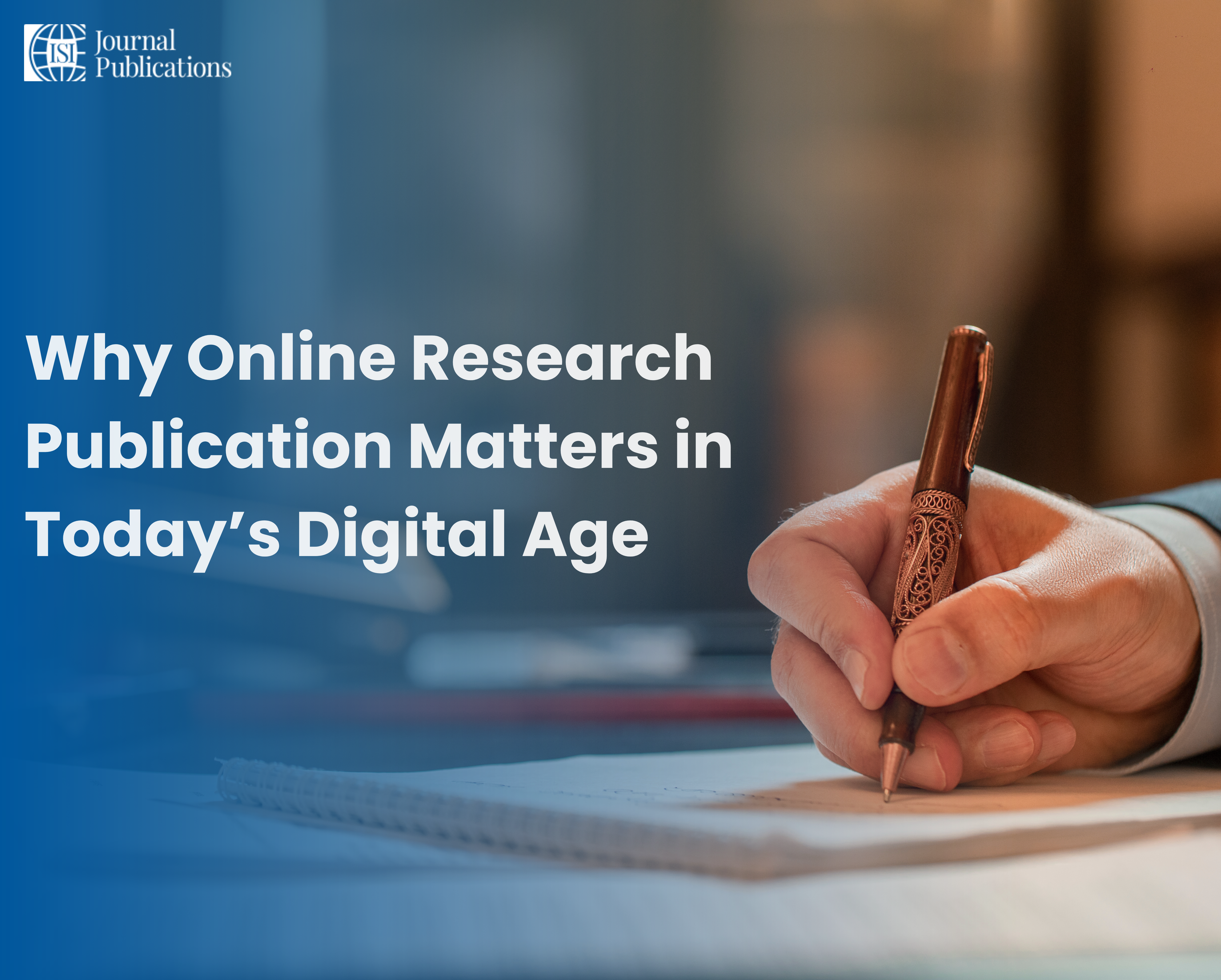The world of scholarly online research publication trends is really changing big time. What used to be dominated by big, old hard copy journals with these complicated submission systems is now transforming into something much more exciting and digital and full of accessibility options. When it comes to being up to date and making a big splash in this new area, knowing what kind of research gets published online every day is key for researchers, institutions and publishers. As digital platforms take center stage, the methods of disseminating scholarly work are being redefined, making research more visible, accessible, and shareable than ever before.
Section 1: Digital Publishing In Research
The online research publication trends refers to the online distribution of academic content, such as journals, articles, conference papers, and datasets. This shift toward digitalization has revolutionized the way research is shared, breaking traditional barriers and enabling wider reach. Today, digital publishing in research empowers scholars to publish more efficiently while allowing global audiences to access cutting-edge findings instantly. With more and more universities and journals transitioning to going digital first and straight to the internet where people read, digital publishing in research is really starting to take over and grow. It’s letting research findings get out quicker and allows people from different fields to collaborate way more easily too.
Section 2: Academic Publishing Innovations
The digital age has brought about numerous academic publishing innovations that are reshaping the scholarly communication process. Sure, there are exciting new ways to show how new stuff works, like things like letting other smart people look at what you’ve done and offering detailed visuals along with sound and video. That really helps to show what you’ve learned and impresses other researchers. These academic publishing innovations not only improve transparency but also encourage interdisciplinary dialogue. Platforms are also now testing some exciting new metrics, called alt metrics, that are meant to really measure how exciting and important different research is beyond looking at just how many citations the paper gets. As cool tech innovations change the world of publishing for academics, they help us make school happen in a more interactive and friendly way.
Section 3: Enhancing Online Research Visibility
With the sheer volume of research published daily online research publication has become a top priority. High visibility ensures that research reaches the right audience, influences policy, and fosters academic collaboration. Researchers are now employing SEO strategies, optimized keywords, and social media promotion to enhance online research visibility. Sites like ResearchGate, LinkedIn, and Twitter are basically super tools for sharing scholarly stuff now. Improving online research visibility not only boosts the reputation of individual researchers but also amplifies the impact of their findings in real-world applications.
Section 4: Scholarly Communication Trends
The way students communicate and collaborate has developed, giving elevation to new scholarly communication trends. From preprint servers to real-time collective writing tools, students now have more methods than ever to share their ideas and obtain feedback. These educational contact trends in digital research sharing stress exposure, speed, and clarity. Tools like Overleaf, which qualifies for collective LaTeX writing, and Zenodo, where individuals can transfer data, really allow things to move smoothly. As scholarly communication trends develop, they recollect a growing need for community-driven, tech-enabled research ecosystems.
Section 5: Open Access Research Publication
Open access publication is really powerful in helping to spread knowledge widely and broadly. This idea of giving knowledge to everyone who might want to read it isn’t just a nice intention, but something that is really making a splash by giving everyone access and making information freely available. Unlike traditional models, open access ensures that anyone, anywhere can read scholarly work without a paywall. The growth of open access research publication has increased research reach, citation rates, and global collaboration. Movements like Plan S and places like PubMed Central signal strength and momentum building around this whole thing. As more and more open access research publication insists that scholarly research be freely shared and more funding bodies push for this openness, the future looks bright for scientific sharing that borders on being 100% free to unrestricted eyes.
Section 6: Emerging Technologies In Publishing
Emerging technologies in publishing is at the vanguard of changing academic publishing. Arising technologies in publishing, such as artificial intelligence, blockchain, and machine knowledge, are facilitating editorial workflows, improving peer assessment, and providing research integrity. AI can assist in plagiarism detection and manuscript revision, while blockchain pledges secure and translucent authorship narratives. These emerging technologies in publishing are not only improving efficiency but also fostering trust and innovation. As these technologies mature, their influence on the scholarly world will only deepen, revolutionizing how we create and consume research.
Section 7: Future Of Academic Journals
What lies ahead for traditional journals in the digital era? Sure, future of academic journals won’t just be the old, tried and true kinds and won’t stick with the newfangled digital ones only. We’re looking at an exciting marriage of past practices and trendy technology. People will blend old and new. While peer review is still #1 and respect its high standing, there will be strong emphasis now on free access at affordable prices, a preference for journal article editing is the right away rather than waiting for publication after reviewing and afterward checking quality from comment contributors. More ready access means now more immediate feedback, people don’t have to wait to see what the experts say about research results. And as we’re all looking ahead at what new kinds of journals will be like in the future, we’re also going to see that they’re really moving towards being interactive and using multimedia along with data sets. Engaged readers want lively content to read, and information that’s moving beyond just flat text to more dynamic stuff with all sorts of other things like videos and interactive pie charts and beautiful graphics coming through too. So journals that respond right, adapting their formats to all that, are going to really stand out in the future. As publishing models evolve, the future of academic journals must balance credibility, accessibility, and technological advancement.
Section 8: Research Dissemination Strategies
Effective research dissemination strategies are key to ensuring academic work reaches a broad and relevant audience. Beyond putting work in print by sending papers to journals for peer review, researchers are now leveraging blogs, webinars, podcasts and email newsletters to share their ideas and insights with a wider audience and keep regular communication going with stakeholders also. Targeted outreach, audience segmentation, and multilingual publishing are examples of impactful research dissemination strategies. So there are ways that really help connect academics to regular people and bring super complicated findings into really useful stuff. A strategic approach to research dissemination strategies increases the likelihood that research will inform policy, education, and industry practices.
Section 9: Impact Of Online Publishing
There’s no doubt that with how powerful digital periodicals and publishing have gotten, everything about scholarly work has changed a lot. It has accelerated understanding sharing, decreased publication barriers, and made a more inclusive educational landscape. However, the effect of online publishing also carries challenges, including cases of quality governance, data excess, and predatory journals. Balancing speed with rigor remains crucial. Despite these concerns, the positive impact of online publishing—especially in global knowledge democratization—is undeniable and continues to drive the future of academic communication.
Conclusion
The dynamic shift in academic publishing is driven by evolving online research publication trends. From digital publishing in research to academic publishing creations, the academic globe is adopting transformation at an exceptional pace. The rise of open-access analysis publications, emerging technologies in publishing, and enhanced online research visibility emphasise a growing dedication to translucency and accessibility. Comprehending scholarly contact trends, designing effective research dissemination systems, and anticipating the future of academic journals are all essential for thriving in this new digital era. As researchers evolve and institutions go along with these trends in digital research sharing, finding ways to make an impact and team up with people worldwide will be really important.















